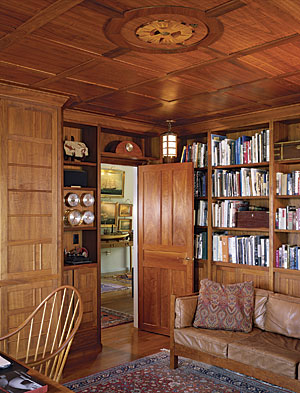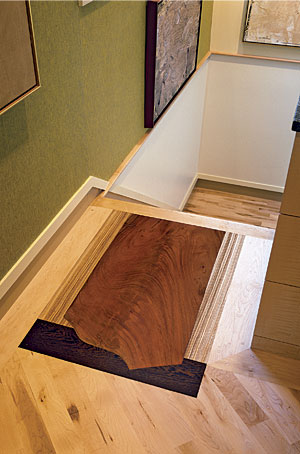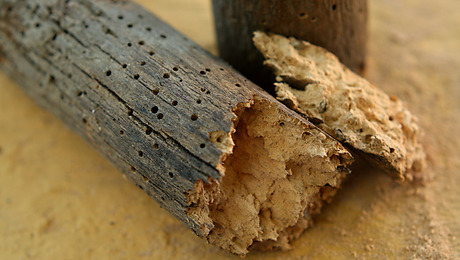Inspired Inlays
Whether sophisticated or whimsical, simple or elaborate, the inlay process begins in the mind of the artist
For thousands of years, a wide variety of wood has been used to cover floors, walls, and ceilings. For nearly as long, talented artisans have been practicing the craft of inlay. Whether sophisticated or whimsical, simple or elaborate, the inlay process begins in the mind of the artist. The design stage could require intricate drawings, full-scale mock-ups, templates, and patterns. And whether the inlay is made of a handful of parts or a hundred tiny pieces, careful attention goes into selecting an array of wood species that achieves the desired combination of color, grain, and texture. Only after this extensive preparation is complete can the inlay artist begin to cut and install each piece. Some of the intricate work pictured here took more than 300 man-hours of installation time alone.
Starring the entry
With its center star of African wenge, American cherry, and figured maple, the center of this medallion points the way to the living areas of the home. Canary wood and purple heartwood scallops surrounding the star brighten the entry and highlight the medallion. Handcut with a scrollsaw, the intricate Victorian border of Australian lacewood and eastern black walnut provides the final elegant touch. Designer: David Marzalek, DM Hardwood Designs, Mission Viejo, Calif. Installers: David Marzalek and Dustin Marzalek. Photo by Chris Haston.
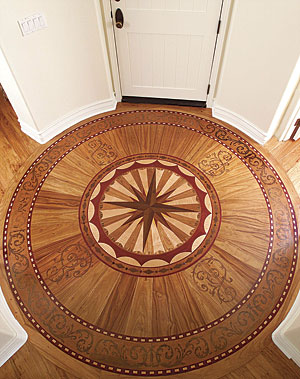
Modern inlay art
When a visit to a lumberyard yielded a handsome slab of walnut, the owner of a private art gallery decided to showcase it as part of this elegant inlay. Gracing a second-floor landing, the walnut is framed by two planks of light maple and a band of deep-purple heartwood, proof that not all art hangs on gallery walls. Gallery design: Scott Simons Architects, Portland, Maine. Installation: Mark Dorsey Construction. Photo by Brian Vanden Brink.
Floored by Florida’s forests
Based on an antique topographical map of Florida’s original forests, this 83-in. by 72-in. inlay graces the Goodwin Heart Pine showroom. The design includes a compass rose based on old sea charts and a museum compass. The compass’s scallop-shell inlays reflect the owners’ scalloping hobby. All pieces were hand-cut with a scrollsaw, then surrounded by centuries-old reclaimed longleaf heart pine and cypress. Designer: Andrew St. James, Goodwin Heart Pine, Micanopy, Fla. Installers: Andrew St. James and Endres Layton. Photo by Carol Goodwin.
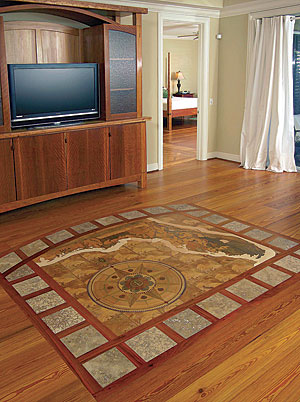
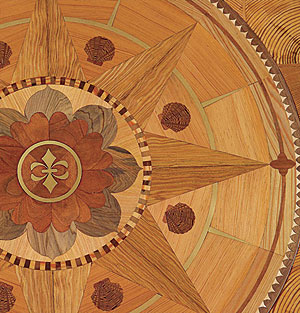
Rounds of roses
River-recovered logs sliced and scribed into each other create a unique backdrop for this entryway medallion. Australian lacewood and tiger maple were used to fashion the Victorian lace scroll border. Hand-drawn, carved, and painted, the roses were inlaid into the center of the tiger-maple oval. Designer: David Marzalek, DM Hardwood Designs, Mission Viejo, Calif. Installers: David Marzalek and Darren Marzalek. Photo by Chris Haston.
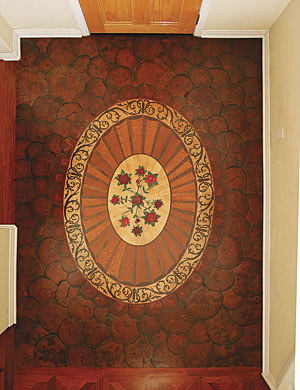
Ceiling showcase
After Florida’s Fairchild Tropical Botanic Garden, home to a large collection of exotic palm trees, was ravaged by Hurricane Andrew, furniture maker Tom Moser was asked to find a use for the salvaged wood. Inspired by the logo of the Osher Map Library in Portland, Maine, he fashioned eight compass-rose medallions, using more than 25 species of rare wood in each. Too precious to hide underfoot, one of these medallions graces the ceiling of Moser’s frame-and-panel American black-walnut library. Design and installation: Tom Moser, Auburn, Maine. Photo by Brian Vanden Brink.
